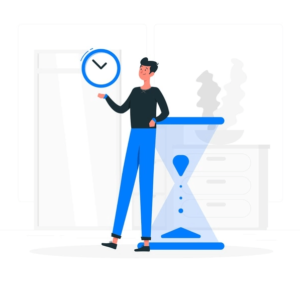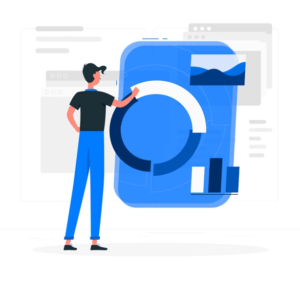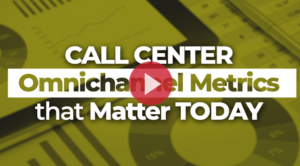Call Center agents’ main goal is to handle as many calls as possible effectively and without wasting time. However, it is obvious that insufficient training, incompatible interfaces and other factors might result in an increase of Average Handling Time. The AHT is a KPI that contact centers always strive to improve. Of course, there are rational answers to this organizational challenge, including reducing call center AHT while also ensuring quality work and performances.
But, how is the Average Handling Time (AHT) calculated? What are the appropriate methods to maximize it? What are the consequences if it grows or decreases? Everything is explained in this article.
What is the Average Handling Time (AHT) for Contact Centers?
 The average call handling time (AHT) is frequently used to determine individual agents’ effectiveness and the performance of the customer service organization as a whole. It may be a valuable tool for establishing standards against which the customer relationship center can push its customer service goals. While AHT is generally used to determine the duration of a client’s phone conversation, a business that uses an omnichannel strategy for customer care can compare phone support to other channels.
The average call handling time (AHT) is frequently used to determine individual agents’ effectiveness and the performance of the customer service organization as a whole. It may be a valuable tool for establishing standards against which the customer relationship center can push its customer service goals. While AHT is generally used to determine the duration of a client’s phone conversation, a business that uses an omnichannel strategy for customer care can compare phone support to other channels.
The average call handling time (AHT) is also one of the oldest and most important key performance indicators (KPI) for contact center performances. It is much more critical in determining the economic model of a partnership when outsourcing call center activities.
The following formula is used to get the AHT (Average Handle Time):
the duration of the exchange itself (AHT); the duration of the caller’s wait (MEA); and the duration of the file’s post-call processing (ACW).
AHT = DMC (length of a conversation) + MEA (mean duration of a call on hold) + ACW (after call work or duration of back-office processing following the call)
The average time required to process a call varies according to a number of factors:
- the customer profile (individual/professional, beginner/expert, age, etc. );
- Reason for the call (information request, commercial request, need for technical or legal assistance, collection, or claim, etc. );
- The agent’s profile and skills (beginner/confirmed, generalist/specialized, trained/untrained, etc. );
- Type of activity (e-commerce, telecommunications, banking, etc. );
- Tools and technologies used (CRM, knowledge base, macros, etc.)
To demonstrate this perspective, consider the following examples of AHT discovered on current customers: 3 to 4 minutes for e-commerce customer service; 5 to 6 minutes for telco customer care (excluding technical help); 10 to 12 minutes for legal aid, etc. A bigger example demonstrated by Forbes shows that if your agents’ occupancy rate is greater than 85%, then they are likely overworked and in need of more help?
Please keep in mind that the AHT is an “interpretation”. In other words, some exchanges are shorter than others when identical criteria are used. Similarly, some agents will be faster than others when providing the same service.
What are the benefits of managing and monitoring the AHT?
Understanding how to properly monitor your AHT is critical if a company wants to successfully outsource its contact center. This indicator enables to:
- Predict the processing time of incoming call flows in real-time and hence attempt to decrease client wait times;
- Estimate and adapt the contact center’s activity load;
- Organize the teams in accordance with this load (staffing forecast).
 Average handling time varies according to a business’s customer experience philosophy, the products/services it delivers, and the organizational structure of its support group. AHT is a measure that, in general, reflects an attempt to improve customer exchange.
Average handling time varies according to a business’s customer experience philosophy, the products/services it delivers, and the organizational structure of its support group. AHT is a measure that, in general, reflects an attempt to improve customer exchange.
However, a lower AHT does not always indicate that a call center works optimally. Agents mustn’t rush consumers to the phone to lower their AHT, even though this is their obligation. The average handling time should typically not be excessive: it should be ideal for the assistance consumers require and the capabilities of the call center.
On the other hand, monitoring and analysis enable the identification of the causes of AHT movement. However, it is vital to understand the reasons appropriately to deliver the best feasible reaction.
The AHT is composed of three components, each of which has the potential to affect the productivity index:
- Increase or reduction in the duration of a discussion
- Increase or reduction in the length of time spent waiting
- Increase or reduction in the time required for post-call processing
While variations in a single element are possible, they can also come from two or all three factors. Most crucially, a fixed average handling time does not imply that no movement occurs on any of the three variables.
It is therefore critical to monitor the AHT at a fine granularity to prevent missing a factor, even when everything appears to be going well.
How can AHT be optimized without sacrificing quality or performance?
Naturally, every manager strives to increase traffic flow and reduce expenses. To put it another way? They aim to reduce the time it takes to handle a call and optimize it to be as brief as feasible. However, caution must always be exercised; the concept of time must never take precedence over the quality of the solution offered. The danger is that by attempting to minimize the length of a call at all costs, the telephonist decreases their odds of meeting the customer’s request. The latter is likely to call back for further information, which is detrimental to the brand’s reputation! It is preferable to spend a few additional minutes resolving the issue entirely on the first call.
How can a caller/customer discussion be optimized without sacrificing quality?
 In terms of outbound campaigns, if you don’t make sales, you don’t earn money as a salesperson. So what is the trick to overcoming a sales slump? How do you address this as a leader? Jason Cutter, CEO of Cutter Consulting Group, author, and podcaster, provides direct and concrete advice on this subject!
In terms of outbound campaigns, if you don’t make sales, you don’t earn money as a salesperson. So what is the trick to overcoming a sales slump? How do you address this as a leader? Jason Cutter, CEO of Cutter Consulting Group, author, and podcaster, provides direct and concrete advice on this subject!
1. Develop effective training for agents
At the heart of any optimization is a collection of general instructions. In customer relationships, this begins with teaching your agent teams the tools they will be using. Training that also enables you to maximize your call center agents’ dedication! This training must be well-planned and customized: you must devote sufficient time covering all necessary functions and ensuring that your workers have mastered their equipment.
Untrained agents can be a significant impediment to AHT. Agents who are not adequately trained may be more prone to fumble through a call or go off on tangents, wasting both their and the customer’s time. A successful contact center thrives when employees maintain a flexible support discussion without being unduly sensitive to interruptions. Above all, do not omit anything. Every day, successful training saves time!
In today’s context, businesses must have the necessary competence to adopt omnichannel capabilities. Having the proper mentality is not always sufficient; to develop, you must surround yourself with the appropriate people who can assist you in making the change, staying educated, and taking ownership of what you don’t know. Learn more about the Call Center Omnichannel Metrics that Matter Today.
2. Concentrate, efforts management and Data
It’s inconvenient to switch between tools to manage calls, emails, and chats, as well as client databases… Access to these disparate duties via a unified, ergonomic, and flowing interface simplifies each customer interaction. This will save your teams time by avoiding searching for information or entering the same data many times. Choosing a concentrated set of interfaces results in significant time savings, and that’s where CCaaS Solutions comes in! For 2022 and beyond, Contact Centers must focus on improving their technologies by having a unified contact center solution encompassing all their tools, customer Data, and agents’ efforts.
3. Enhance the agent’s call handling abilities
To maximize call handling efficiency and hence decrease AHT, call center agents must remember that they are in charge of the discussion and must not allow consumers to direct them. When consumers veer off course, the agents’ responsibility is to get them back on track. However, they still require instruction intact and the ability to retain their hand while staying agreeable. Managers find the perfect balance between letting an agent handle the situation and giving instructions by utilizing call whispering tools.
Consequences for AHT variations
 We see from the previous examples that the analysis must be as precise as possible. It would be best to analyze the causes for the calls (e.g., do you observe that some requests skew your initial AHT estimate in a specific way or over an extended time). Also you by listening to individual interactions, you can determine the quality of the agents’ work.
We see from the previous examples that the analysis must be as precise as possible. It would be best to analyze the causes for the calls (e.g., do you observe that some requests skew your initial AHT estimate in a specific way or over an extended time). Also you by listening to individual interactions, you can determine the quality of the agents’ work.
That is why you must supplement the AHT with qualitative key performance indicators (KPIs) such as listening scores, Customer Satisfaction (CSAT), Net Promoter Score (NPS), and Customer Effort Score (CES). In that regard, you can learn more about the most important Key Performance Indicators for customer services from our guide.
Without this examination, an unstable AHT has the following consequences:
– Human consequences: need to alter workforce levels (too many or too few) and address an issue with advisors’ job quality (training, coaching)
– Financial ramifications: a lower AHT leads in underused call center agent time in comparison to the remuneration initially planned.
Conclusion
Customers expect their support interactions to be as efficient as possible. When people are forced to contact a call center, it is frequently due to an inconvenience. AHT may be viewed as a critical metric for mitigating this discomfort and determining the efficiency level that consumers anticipate from an inbound support contact.
If a large amount of calls is affecting AHT negatively, try adding more self-service alternatives to counter these calls. Both chatbots and virtual assistants can assist desktop and mobile users, and training them about interactive voice response (IVR) might minimize the number of support engagements per call. Several factors contribute to efficiency, but they all can result in lower AHT and improved client experiences.
To optimize AHT, the following levers must be pushed:
- delivering sound initial training and continuous support for counselors
- enhancing capabilities through local management;
- specialized teams to increase speed;
- Opt for service digitization and task automation;
Utilize the benefits of interactive voice response (IVR) and call bots (voice exchanges) for routing (directing calls) or transactional reasons (processing the most common requests 24 hours a day).
At NobelBiz, we offer solutions for call centers that are designed with enterprise-level reliability and security standards in mind. We take care of everything to focus on running your business.
- Omnichannel contact center software NobelBiz Omni+ with fast implementation and 24/7 support.
- Voice carrier network designed especially for contact centers with the best rates/prices.
NobelBiz is the promise keeper in delivering customized, high-quality solutions for your contact center that exceed your expectations. Working with our comprehensive suite of solutions, you can improve your contact center productivity by quickly shifting contact-center operations to the cloud.

Michael McGuire is a contact center industry expert with almost two decades of experience in the space. His experience includes roles as Director of Contact Center Digital Transformation at NobelBiz, and as Director of Operations at FLS Connect, managing multiple call centers. As President of Anomaly Squared and Targeted Metrics, Michael successfully transitioned companies into remote operations and significantly boosted revenues. With a strong background in customer service, leadership, strategic planning, and operations management, Michael excels in driving growth and innovation in the call center space.
Mike is also a proud Board Member for R.E.A.C.H Trade Group, promoting consumer protection and satisfaction and Co-host of the Off Skripted Podcast – a show about Life, Call Centers and everything in between.







